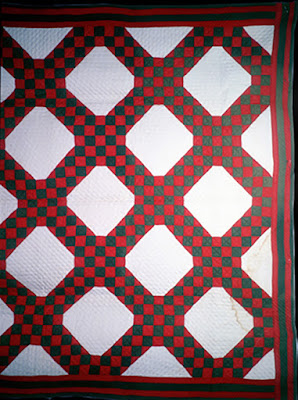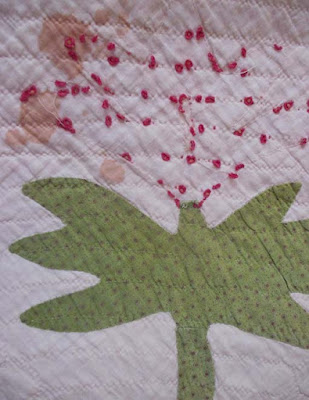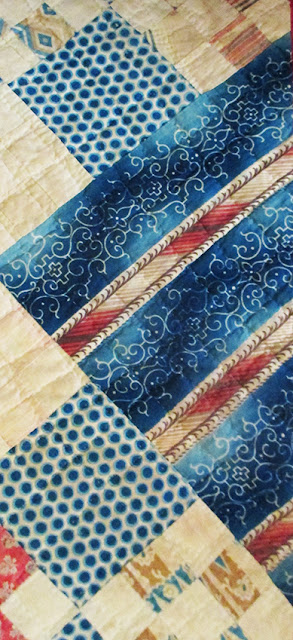Quilt attributed to Frances Kendrick Massey (1867-1952)
Documented by the Louisiana Folklife Program in 1985.
At least five quilts from the same maker are pictured at the Quilt Index, brought in by a family member who lived in Claiborne Parish and "found the quilts in the maker's 'Hope Chest' and does not believe [they have] ever been used." Frances married James Wallace Massey in 1901 and this is very possible. They did not have children and the quilts may have remained unneeded.
The teal solid is probably colored with a synthetic dye, quite fugitive
to light. It looks like the quilt has been folded with
the streaked area exposed to sunlight.
Irish Chain from the trunk,
this one showing more wear.
Variation of BlockBase #1022
For some reason the quilts are labeled as made in Oregon, although Martha Frances Kendrick Massey (1867-1952) was born and died in Claiborne Parish and spent most of her life in the vicinity of Haynesville, a town up by the Arkansas state line.
She is buried across the line in Arkansas's Shiloh-Buckner
Cemetery with her husband and his family.
Another Irish Chain variation---two blocks making
a complex pattern.
Frances was 50 years old when the Hearth & Home pattern was published and could very well have made this quilt (and the others in solid fabrics) about 1920 when that fabric style was still popular in the South.
This one pieced of prints seems easier to date. The periwinkle
blue looks late-19th century and that appears to be black
so: after 1890. About 1900?
Pattern is BlockBase #2433
published as Swallows in the Window in 1930
in the Kansas City Star.
The quilt doesn't look that recent--
Again a pattern handed around and eventually published?
Another one with printed fabric but just two:
a wide floral stripe and a shirting.
The family thought this might be an original pattern of Frances's
design but there are other examples using log cabin rectangles
to make a dark and light tessellation.
The closest published pattern is "The Monument"
published in the Ohio Farmer about 1890. Frances's
quilt might be from that decade or a little earlier.
Example from the Michigan Project.
Read more about Monument quilts:
http://barbarabrackman.blogspot.com/2010/09/intepreting-old-patterns.html
John Pinckney Kendrick (1826-1899) and Rachel Lowe Kendrick (1827-1900)
Frances's parents. Her mother lived until the 20th century so she may
have had a hand in the quilts too. And then there are Frances's three sisters and four sisters-in-law.
Sister-in-law Mary Lue Petillo Kendrick (1861-1941) with her husband William Kendrick. Mary Lue and family went to Texas in the early 20th century but dated by the childrens' ages (Oddie D in his father's lap was born in 1892) the photo was taken in Louisiana. William has a patchwork quilt on his chair and the photographer used the reverse of quilts for a background, a typical setup by itinerant photographers at the time.
From William's Find-a-Grave file.
https://www.findagrave.com/memorial/48690295/william-austin-kendrick


















































